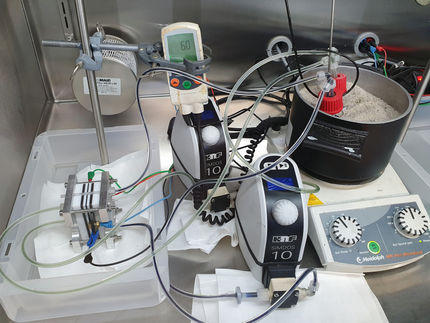Chemists produce hexa-nitrogen for the first time - the most energy-rich substance ever formed
"...a huge advance in nitrogen chemistry": future application as environmentally friendly energy storage conceivable
A chemistry team at Justus Liebig University Giessen (JLU) has successfully produced hexa-nitrogen (N₆) for the first time. This form of pure nitrogen, which had previously only been predicted theoretically, is the most energy-rich substance ever formed. The molecule consists of six nitrogen atoms in a chain and stores enormous amounts of Energy, which can be recovered through residue-free decomposition to N2 ("normal" nitrogen, which makes up 78 percent of our air). This makes a future application as an environmentally friendly energy storage system conceivable. The JLU team has published its results in the journal "Nature".
To produce N6, the research team led by chemist Prof. Dr. Peter R. Schreiner reacted chlorine gas (Cl₂) or bromine (Br₂) with silver azide (AgN₃). The resulting reaction products were trapped in an argon ice matrix at very low temperatures (-263 °C) in order to stabilize them and detect N₆. They also succeeded in producing N₆ in its pure form as a thin film at -196 °C (the temperature of liquid nitrogen). The researchers assume that hexa-nitrogen remains stable in this state for over 100 years.
The team, which includes Dr. Artur Mardyukov and Weiyu Qian from the Institute of Organic Chemistry at JLU in addition to Schreiner, was able to detect hexa-nitrogen using various methods. The chemists used a combination of infrared and UV/Vis spectroscopy to measure light absorption. By incorporating heavy nitrogen atoms (15N isotopes) and using complex computer models, they were able to prove that it is indeed the new molecule N₆.
At room temperature, the substance has a lifetime of around 35 milliseconds. "That's enough to capture it and study it - a huge step forward in nitrogen chemistry," emphasizes Prof. Schreiner. When N₆ is broken down into normal atmospheric nitrogen (N₂), more than twice as much energy is released per gram as with TNT - and without any environmentally harmful by-products. "In fact, this would make hexa-nitrogen the most efficient energy store," explains Schreiner, for whom the discovery is a real breakthrough: "It is the first time that an isolable, neutral nitrogen molecule with more than two atoms has been produced in the laboratory. This opens the door for the targeted development of new and clean high-energy materials."
The chemist knows that there are also challenges associated with the discovery: "Handling very high-energy compounds is always associated with risks if their decomposition happens in an uncontrolled manner and all the energy is released at once," he explains. In addition to researching other poly-nitrogens, future work will therefore also focus on the safe production and handling of hexa-nitrogen, the controlled conversion to nitrogen (N2) and transferring the results from the laboratory to larger scales.
Note: This article has been translated using a computer system without human intervention. LUMITOS offers these automatic translations to present a wider range of current news. Since this article has been translated with automatic translation, it is possible that it contains errors in vocabulary, syntax or grammar. The original article in German can be found here.
Original publication
Other news from the department science

Get the chemical industry in your inbox
By submitting this form you agree that LUMITOS AG will send you the newsletter(s) selected above by email. Your data will not be passed on to third parties. Your data will be stored and processed in accordance with our data protection regulations. LUMITOS may contact you by email for the purpose of advertising or market and opinion surveys. You can revoke your consent at any time without giving reasons to LUMITOS AG, Ernst-Augustin-Str. 2, 12489 Berlin, Germany or by e-mail at revoke@lumitos.com with effect for the future. In addition, each email contains a link to unsubscribe from the corresponding newsletter.



























































